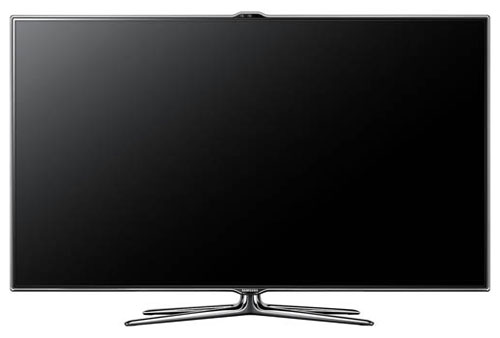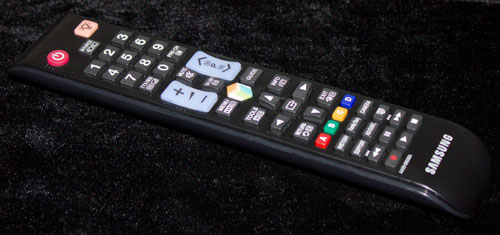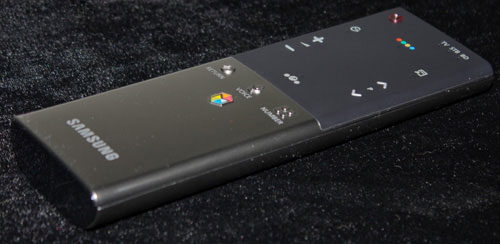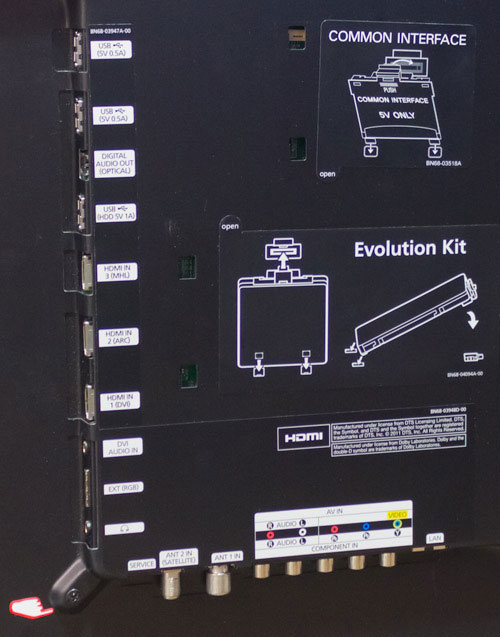Time for the Samsung UE40ES7000 LED LCD TV to go through the HDTVTest review process! We’ve already seen the ES8000 series, and other than some video processing issues which appear to be specific to the model sold in European countries, we were happy with the performance. Last year, the 7000 range performed the same as the 8000, with the differences being in styling. Will that be the case this year? Is the ES7000 just a cheaper, less luxurious-looking ES8000? The only spec difference that could affect image quality is the 7000’s inclusion of “Micro Dimming” rather than “Micro Dimming Ultimate”; whether or not this translates into anything tangible is for our eyes and test instruments to discover.
Comparisons aside, let’s see what we have here: a 1920x1080p panel (which has become ubiquitous to the point where we may as well stop mentioning it), a tuner which supports the DVB-T2, DVB-S2 and DVB-C standards (for UK readers, that translates into Freeview HD and Freesat HD support), integrated wireless connectivity for use with Samsung’s Smart TV facilities, and 3 HDMI inputs. The UE40ES7000 also features a built-in camera and microphone, for use with voice and gesture controls (and Skype video calling), as well as is 3D-capable, if that’s your thing. Let’s see how it performs!
Note: The specific model we reviewed was the Samsung UE40ES7000UXXU which denotes the 3-pin-plug United Kingdom version. Although we did not test the larger, 46-inch Samsung UE46ES7000, there shouldn’t be any major difference in picture performance given similar specifications within the ES7000 range.
Framed in black, we actually prefer this aspect of the UE40ES7000’s styling compared to the silver finish on the ES8000, although your mileage may of course vary. The border surrounding the panel is nearly non-existent, and only curves upwards to situate the webcam/microphone unit. The outermost edge has the Korean manufacturer’s usual glass-like acrylic trim, which looks as good today as it did when they first introduced it (and when other brands unsurprisingly imitated it).

Unlike the ES8000 with its U-shaped stand, the ES7000 is supplied with the old “chicken foot” variant (the official name is the “Quad Stand”, by the way). We have to call Samsung out on the stand, because on the review sample we received, we had serious difficulty in getting the screws on the television’s back-plate to line up with the stand. What’s more, the design of the back plate makes it hard to get a short manual or electric screwdriver in.

The remote control supplied with the 40ES7000 is the same as the ES8000’s, with the nonsensical omission of the Aspect Ratio button on the European model (it’s still there on the US/Canadian variant, but over here it’s been replaced with a shortcut to the “Family Story” app). Other than this annoyance, the remote feels great to use.

The secondary remote control, with touch pad and built in microphone, is also supplied with the ES7000.
There’s one less HDMI input than last year, but aside from this, the Samsung UE40ES7000 shouldn’t leave anyone too disappointed in terms of connectivity. We’re happy to see the inclusion of a satellite tuner, which grants UK users (and perhaps those living in Northern France?) access to Freesat channels. SCART devices are plugged in with a breakout cable; Component devices connect directly via RCA connectors.
 |
| Rear connections on Samsung UE40ES7000 |
We’ve covered the more mundane aspects of menu operation in our review of the nearly identical ES8000, so a quick recap of the less pedestrian picture setup controls: the UE40ES7000 features a 2-point Greyscale correction screen, as well as a 10-point correction menu, a basic Gamma correction slider (useful for tailoring the TV’s images to differently lit viewing environments), and a 3-axis colour management system (CMS).
![[Advanced Settings] menu](https://www.hdtvtest.co.uk/news/wp-content/uploads/2018/04/hdtv_Samsung-UE40ES7000_picturemenu.jpg) |
| [Advanced Settings] picture menu |
It doesn’t feature any sort of THX or ISF certification, but we’ll find out if Samsung are managing fine on their own in terms of out-of-the-box image quality when we measure and analyse the output of the HDTV.
| Jump To: 1. DesignNext: Calibration3. Performance |
jQuery(document).ready(function($) { var toc = $("#tableofcontents").html(); $("#tablecontents").html(toc); });